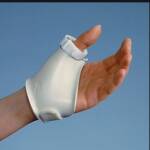Injury: De Quervain’s Tenosynovitis
De Quervain’s is a painful condition affecting the tendons on the thumb side of the wrist. Parents, especially mothers of young children, are often at risk due to the anatomy and positioning required for the typical lifting of a child from under the armpit region. Forceful, sustained thumb abduction (forming an L with the thumb and first finger) combined with ulnar wrist deviation (wrists positioned towards the floor when lifting) may contribute to the development of this condition1.

Prevention: Instead of lifting your child from under the armpit region, start by standing behind your child. Reach your hand around and across their chest while using the other hand to scoop their bottom halfway between their knees and buttocks region to perform a scooping-cradling position. The size of the child and the strength of the parents will play a role in alternative lifting. Notably, wearing a hard and static thumb splint can also help manage thumb/wrist pain1.
Injury: Lateral Epicondylitis (Tennis Elbow)
Commonly known as Tennis Elbow, resisted extension of the wrists while gripping/lifting can place an increased load and force on the extensor tendons at the elbow. If you’re anything like me, you notice this when you’re trying to throw open your large and heavy double stroller.
Prevention: Instead, try laying the stroller on the floor and unfolding it step by step. Once ready to bring it upright, use an underhand grip (palms facing the sky) or neutral grip (palms facing one another) to lift and pull. A wrist brace and elbow counterforce brace can also help to manage the pain associated with this injury.
|
|
|
Injury: Shoulder Impingement Syndrome
This type of injury can easily occur when performing childcare activities such as lifting a child, passing a child from one person to another, getting up from the floor, organizing your storage closet, looking for toys/pacifiers under the couch, or almost anything involving reaching with or without resistance. When the rotator cuff muscles rub against the bony anatomy of the shoulder, causing inflammation, it may narrow the already small space where these tendons reside, creating significant pain and/or weakness with reaching and lifting activities.
Prevention: Be sure always to hold children/objects close to your body’s center and not outside your base of support. To do this, pretend there is a small circle around yourself, and keep your child or lifted object within that circle to avoid mechanical stress on the rotator cuff1.
When Parenting Causes Pain
Parenting is a challenging but highly rewarding experience. It is important that you first take care of yourself, so that you can provide the best care possible for your little ones. Considering our body mechanics, positioning, and the way we handle our kids and their equipment, all of these factors can help minimize the risk of orthopedic-related pain and injury, allowing you and your child to meet their needs. If you’re experiencing pain or injury, reach out to your nearest Athletico for a Free Assessment.
The Athletico blog is an educational resource written by Athletico employees. Athletico bloggers are licensed professionals who abide by the code of ethics outlined by their respective professional associations. The content published in blog posts represents the opinion of the individual author based on their expertise and experience. The content provided in this blog is for informational purposes only, does not constitute medical advice and should not be relied on for making personal health decisions.
Reference 1. Cooper, Cynthia, 2014. Fundamentals of Hand Therapy; Clinical Reasoning and Treatment Guidelines for Common Diagnoses of the Upper Extremity.
About the Author:
Erik J. Krol is a Hand Therapist/Occupational Therapist, father of two, runner, and former college athlete. Erik uses his background education in kinesiology and professional training in hand therapy to provide recommendations on preventing injuries during daily roles and routines. Follow Erik's work and interests in remaining healthy and, more importantly, functional to achieve family, work, and personal goals while combating the environmental and aging challenges.

 width="900"
height="356"
>
width="900"
height="356"
>


